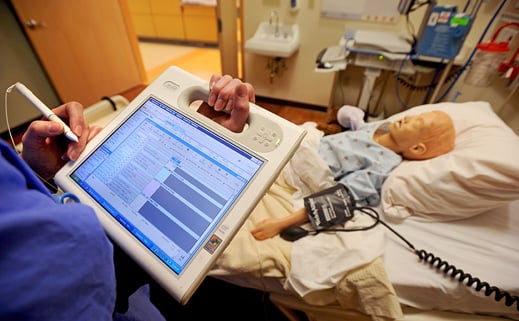At Fake Hospital, Kaiser Runs a Testing Ground for New Technology
At the 37 hospitals operated by Kaiser Permanente, the giant health nonprofit with over 160,000 employees, nurses don a fluorescent sash when preparing medications. It means: “Don’t bug me.”

Kaiser came up with the sash a few years ago, when it was looking for a way to cut medication errors. At least a million drug mix-ups occur in the U.S. each year, and many are due to overly busy, distracted nurses. So Kaiser brought a group of nurses to its Garfield Innovation Center, in San Leandro, California, to brainstorm. One participant attempted to fix a paper sign to her head, another to duct-tape a flashing iPhone onto her clothing. Eventually, they hit on the idea of the sash. Errors dropped by 85 percent.
Most research at the Garfield center is focused on testing out new technologies. But Kaiser’s director of innovation and technology, Sean Chai, likes the tale of the humble sash because it shows how dramatic improvements can be found in the unsexy logistics of the country’s largest and most complex industry. The U.S. health-care business wastes $750 billion a year, or roughly 30 cents of every dollar spent—and last year, the Institute of Medicine reported that inefficient operations were a significant contributor to that waste. Changes like those pioneered at Garfield could help reduce it.
The 37,000-square-foot center is a facility that’s unique in the United States. It features detailed replicas of hospital rooms with fake patient data loaded onto the bedside computer, a surgical theater with the instruments laid out ready for use, even an ICU with a plastic baby in an incubator.
Chai says some of the ideas about what to test there come from published research and a team of social scientists who rove the supply rooms and surgical wards of Kaiser hospitals, looking for workflow problems. Others come from technology salespeople. Often, he says, companies pitching Kaiser are surprised when they’re asked to install their robotic indoor GPS system or interactive patient information board at the Garfield center. The sale, it turns out, depends on time-and-motion studies and feedback from Kaiser surgeons and janitors who come to the center to role-play their everyday jobs.
One pervasive problem in hospitals is how much time highly trained and well-paid medical staff spend on menial tasks. One study of a Georgia hospital found that nurses spent a quarter of their 12-hour shifts filling in paperwork or getting back and forth from supply rooms. And between 2001 and late 2012, the number of health-care jobs in the U.S. grew by 28 percent.
That’s led some hospitals to invest heavily in automation. Ken King, chief administrative officer with El Camino Hospital, which has locations in the Silicon Valley towns of Mountain View and Los Altos, California, says in 2009 he bought 19 wheeled robots to haul trash, food, and other loads around the hospital. He says they do the work of 12.5 full-time workers.
“The annual cost of each robot at the time we got them was about 52 percent of the lowest-paid position we had,” says King. “Wages have continued to climb, but the cost of the robots has not.”
At Kaiser, Chai says, one significant payoff is all the equipment the organization has decided not to buy. For instance, the center took delivery of several mobile pharmacy carts intended to save on trips to the supply cupboard. An onboard computer tracked all the medications inside and controlled access to them using a biometric lock. But after two days—and several miles—of testing, nurses in the mock wards of the Garfield center said the carts were so heavy they were hard to move around.
In 2012, a visiting executive from a for-profit health company from the Midwest looked suddenly glum when told about that result. “They had bought hundreds of the same carts and then spent millions of dollars to retrofit them because they discovered the same issues,” says Chai.
Keep Reading
Most Popular
Large language models can do jaw-dropping things. But nobody knows exactly why.
And that's a problem. Figuring it out is one of the biggest scientific puzzles of our time and a crucial step towards controlling more powerful future models.
The problem with plug-in hybrids? Their drivers.
Plug-in hybrids are often sold as a transition to EVs, but new data from Europe shows we’re still underestimating the emissions they produce.
Google DeepMind’s new generative model makes Super Mario–like games from scratch
Genie learns how to control games by watching hours and hours of video. It could help train next-gen robots too.
How scientists traced a mysterious covid case back to six toilets
When wastewater surveillance turns into a hunt for a single infected individual, the ethics get tricky.
Stay connected
Get the latest updates from
MIT Technology Review
Discover special offers, top stories, upcoming events, and more.